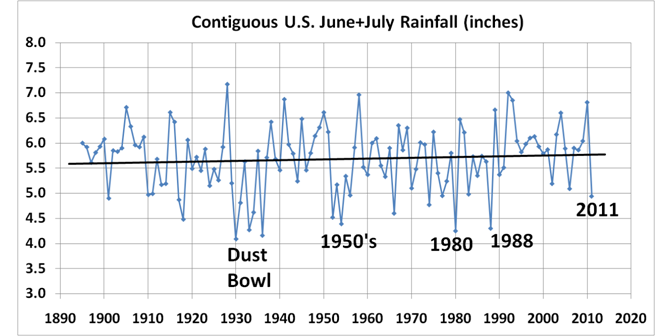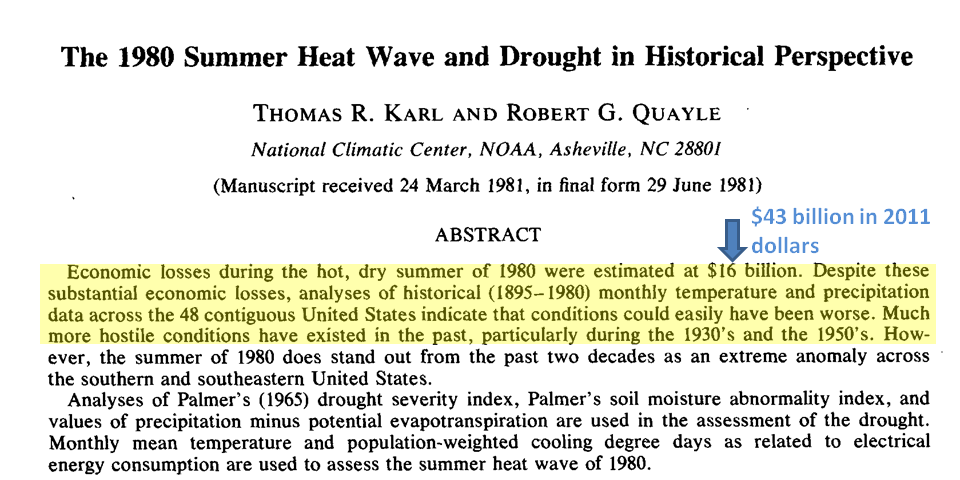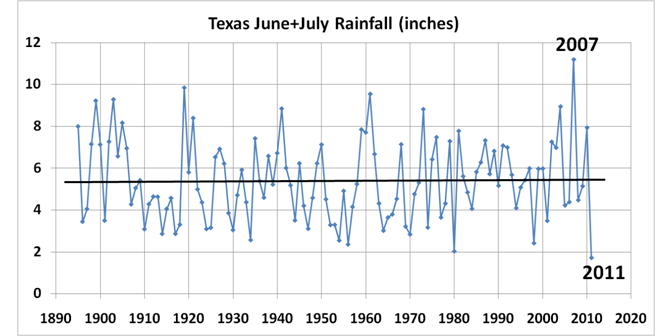One of the most annoying things about the climate change debate is that any regional weather event is blamed on humans, if even only partly. Such unscientific claims cannot be supported by data — they are little more than ambiguous statements of faith.
The current “exceptional” Texas drought is no exception. People seem to have short memories…especially if they were born after most of the major climate events of the past occurred.
Andy Dessler recently made what I’m sure he thought was a safe claim when faulting Texas Gov. Rick Perry for being “cavalier about climate change” (as if we could stop climate from changing by being concerned about it).
Dessler said, “..warming has almost certainly made the (Texas) heat wave and drought more extreme than it would otherwise have been.”
This clever tactic of claiming near-certainty of at least SOME effect of humans on weather events was originally invented by NASA’s James Hansen in his 1988 Senate testimony for Al Gore, an event that became the turning point for raising public awareness of “global warming” (oops, I’m sorry, I mean climate change).
The trouble is that climate change theory predicts changes, up and down, in just about anything you can imagine. So, anything unusual that happens anywhere, anytime, is deemed “consistent” with global warming.
But this tactic can work both ways — a specific drought might have instead been made LESS severe by the general tendency toward MORE rainfall, which is a much more robust prediction of the climate models with warming.
For example, let’s look at June-July total rainfall over the whole contiguous U.S. — which is only 1.6% of the Earth’s surface — over the last 100+ years (August data are not yet posted at NCDC):

What we see are some major drought events, and 2011 is not one of the big ones. The Big Kahuna was the Dust Bowl of the 1930’s. The 1950’s also experienced record droughts (see the animation here). These were before increasing CO2 in the atmosphere could be reasonably blamed for anything, except maybe enhancing plant growth a little.
Even NOAA’s Tom Karl back in 1981, before global warming politics took over his job description at NCDC, authored a paper on how the 1980 drought (which was pretty darn bad, long-lived, and widespread) was less severe than those in the 1930s and 1950s:

Note the price tag of the 1980 drought: $43 Billion. They are saying the current TX-OK drought will run somewhere north of $5 Billion.
But what do we ALSO see in the long term in the above U.S. rainfall plot? If anything, an UPWARD trend in rainfall. This is for the whole U.S., not just Texas….
Yes, I Know Texas is Like a Whole Other Country…
…but it is only 0.14% of the surface of the Earth. It is much easier for naturally-occurring stagnant weather patterns to cause drought (or flood) conditions over one, or even several states, because the descending (or ascending) portions of weather systems cover these smaller regional scales. It’s rare for them to cover the whole U.S.
So, now let’s look at what the rainfall record looks like for Texas:

Even though the August data are not yet available at this writing, I’m quite sure this year’s Texas drought will indeed be a record one….at least in the rather short (in climate parlance) period of record (just over 100 years) that we have enough rainfall data to analyze.
But what else do we see in the record? How about that big rainfall PEAK in 2007? I’ll bet someone can dig up an “expert” back in 2007 saying the Texas floods of 2007 were also caused by global warming.
And note that the long-term rainfall trend in Texas is not downward.
Surely, Dr. Dessler knows that a single data point (2011) does not constitute a “trend”.
The fact is that record dry (and wet) years in relatively small regions are actually quite common…because they usually happen in different places each year. Weather records are location-specific. This year is Texas’ super-drought year. Last year it was in part of Ukraine. Next year it will be somewhere else, maybe multiple places.
And even if droughts (or floods) do end up becoming more frequent, the question of just how much of that change can be blamed on humans versus Mother Nature still remains unanswered…unless you accept the pseudo-scientific faith-based statements put out by the IPCC leadership.

 Home/Blog
Home/Blog



